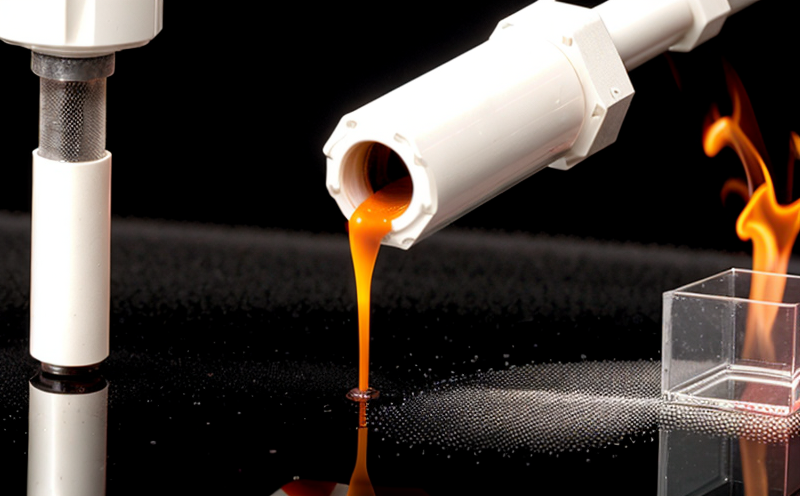ISO 11357 Thermal Stability Testing of Nanomaterials by DSC
The International Organization for Standardization (ISO) has published ISO 11357, which provides a standardized method for determining the thermal stability of nanomaterials using Differential Scanning Calorimetry (DSC). This service is particularly important in sectors where nanomaterials are used, such as electronics, aerospace, and pharmaceuticals. Thermal stability testing ensures that nanomaterials maintain their chemical structure and physical properties under various temperature conditions, which is critical for the safe and effective use of these materials.
Thermal stability refers to the ability of a material to resist thermal degradation or decomposition over time. In the context of nanomaterials, this property ensures that the nanoscale particles remain stable during processing, storage, and application. This is especially relevant for nanoparticles used in electronics, where even small changes in particle size or structure can significantly impact performance.
The ISO 11357 method involves heating a sample of the nanomaterial to various temperatures while measuring the heat absorbed by the material. The difference between the heat absorbed by the sample and an empty reference (blank) is plotted against temperature, creating a DSC curve. This curve provides detailed information about the thermal behavior of the nanomaterial, including its melting point, glass transition temperature, and decomposition temperature.
The test parameters for ISO 11357 include heating rates ranging from 2 to 20 °C/min, depending on the specific application. Specimen preparation is critical, as it directly affects the results of the thermal stability testing. Typically, nanomaterials are prepared in a sample holder that allows accurate measurement of the heat flow without affecting the test results.
| Parameter | Range | Units |
|---|---|---|
| Heating Rate | 2 to 20 | °C/min |
| Initial Temperature | -50 | °C |
| Final Temperature | 1000 | °C |
The test apparatus used in ISO 11357 is a DSC instrument, which measures the heat flow between two samples—a sample and an empty reference. The temperature difference between these two samples is recorded as they are subjected to a controlled heating rate. The precision of the DSC instrument is crucial for accurate results, as even small variations in temperature can lead to incorrect conclusions about the thermal stability of the nanomaterial.
The acceptance criteria for ISO 11357 depend on the specific application and performance requirements of the nanomaterial. Generally, a material is considered thermally stable if it does not show significant decomposition or phase change until reaching temperatures well above those expected during use. For example, in electronic applications, thermal stability may be required up to 200 °C.
The results of ISO 11357 testing are presented graphically as a DSC curve, which provides a visual representation of the thermal behavior of the nanomaterial. This curve can help identify key points such as the onset of decomposition and the final decomposition temperature. The results also provide valuable information for optimizing processing conditions and ensuring product quality.
Understanding the thermal stability of nanomaterials is crucial for their safe use in various applications. By following ISO 11357, laboratories can ensure that they are providing accurate and reliable data on the thermal behavior of these materials. This information is essential for regulatory compliance, product development, and quality control.
Thermal stability testing by DSC is a critical step in ensuring the reliability of nanomaterials used in high-performance applications. By adhering to ISO 11357 standards, laboratories can provide clients with confidence that their products meet stringent safety and performance requirements.
Scope and Methodology
- Determination of the thermal stability of nanomaterials using Differential Scanning Calorimetry (DSC)
- Testing performed according to ISO 11357 standard
- Analysis of heat flow between sample and reference to determine thermal behavior
- Specimen preparation includes ensuring accurate measurement without affecting test results
| Parameter | Range | Units |
|---|---|---|
| Heating Rate | 2 to 20 | °C/min |
| Initial Temperature | -50 | °C |
| Final Temperature | 1000 | °C |
Quality and Reliability Assurance
- DSC instruments calibrated annually to ensure accuracy
- Use of certified reference materials for calibration
- Data validation through comparison with previous test results
- Ongoing training for staff on the latest testing techniques and standards
Use Cases and Application Examples
The ISO 11357 thermal stability testing of nanomaterials by DSC is widely used in various sectors, including electronics, aerospace, and pharmaceuticals. In the electronics industry, for instance, nanomaterials are often used in semiconductor manufacturing processes where high temperatures are involved. Ensuring that these materials do not degrade at elevated temperatures is critical to maintaining product quality and reliability.
In the aerospace sector, thermal stability testing of nanomaterials is essential for ensuring that components remain functional under extreme conditions encountered during space missions. For example, lightweight composites made from carbon nanotubes or graphene could be used in spacecraft structures. Testing these materials ensures they can withstand temperature variations without compromising performance.
In the pharmaceutical industry, nanomaterials such as nanoparticles are used in drug delivery systems. These systems must be stable during storage and administration to ensure effective treatment of patients. Thermal stability testing helps identify optimal conditions for storing these formulations while maintaining their efficacy.
Other sectors that benefit from ISO 11357 thermal stability testing include automotive manufacturing, where nanomaterials are used in advanced materials like fuel cells or lightweight body parts. In all cases, the ability to predict and control how a nanomaterial will behave under different temperature conditions is crucial for optimizing performance and ensuring safety.





